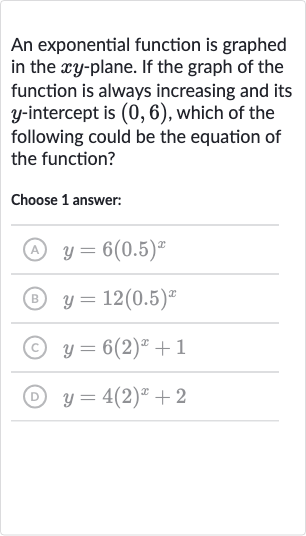Full solution
Q. An exponential function is graphed in the -plane. If the graph of the function is always increasing and its -intercept is , which of the following could be the equation of the function?Choose answer:(A) (B) (C) (D)
- Exponential Function Behavior: An exponential function of the form is always increasing if the base is greater than . This is because as increases, the value of increases when b > 1.
- Finding Y-Intercept: The -intercept of a function is the value of when . For an exponential function , the -intercept is found by setting to , which gives . Therefore, the -intercept is .
- Determining Correct Function: Given that the y-intercept is , we can determine that must be for the correct function. We can now check the options to see which one has a y-intercept of and a base greater than .
- Option (A) Analysis: Option (A) has a base of , which is less than . This means the function is decreasing, not increasing. Therefore, option (A) is not the correct function.
- Option (B) Analysis: Option (B) has a base of , which is less than . This means the function is decreasing, not increasing. Additionally, the -intercept is , not . Therefore, option (B) is not the correct function.
- Option (C) Analysis: Option (C) has a base of , which is greater than , indicating an increasing function. However, when , , not . Therefore, option (C) does not have the correct -intercept.
- Option (D) Analysis: Option (D) has a base of , which is greater than , indicating an increasing function. However, when , . This function has the correct y-intercept of . Therefore, option (D) is the correct function.
More problems from Compare linear and exponential growth
QuestionGet tutor help
QuestionGet tutor help
QuestionGet tutor help
QuestionGet tutor help
QuestionGet tutor help
QuestionGet tutor help
QuestionGet tutor help

